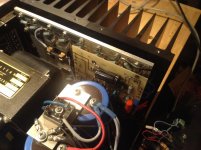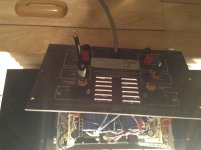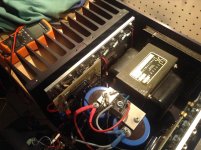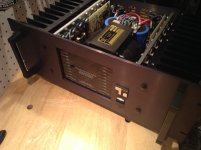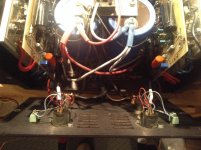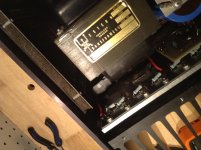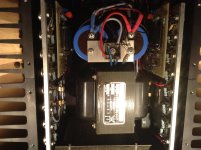Originally posted this in the solid state forum but was told this would be better served here:
A little background first. I recently picked up a preamp which I found out had an inverted phase. So when I picked up the Threshold 400a I decided to set it up properly while I had everything unplugged. Mistake number one. I have a pair of Polk SDA-2b speakers. I knew they didn't like non-common ground amps.
Well the amp blew it's output fuses and became pretty hot. Didn't realize the speaker issue until I removed the amp and put back my other amp. This also got very hot. That's when I realized the speakers were creating huge current.
Now we come to the issue at hand. I have tried biasing the Threshold multiple times based on the service manual floating around. When it's on the bench I can dial it in to the right temperature and it stays stable. When I get the unit back into the system the heatsinks barely heat up. Took it out again and was able to rebias only to have it be cool when it is in the system.
My first question is figuring out what I may have fried with the bad speaker configuration. Do you think I blew the something in the bias network?
Gonna get it onto the bench and try to problem solve. This is my first Threshold with a sliding bias so I would appreciate any clues to what might be wrong.
Thanks
A little background first. I recently picked up a preamp which I found out had an inverted phase. So when I picked up the Threshold 400a I decided to set it up properly while I had everything unplugged. Mistake number one. I have a pair of Polk SDA-2b speakers. I knew they didn't like non-common ground amps.
Well the amp blew it's output fuses and became pretty hot. Didn't realize the speaker issue until I removed the amp and put back my other amp. This also got very hot. That's when I realized the speakers were creating huge current.
Now we come to the issue at hand. I have tried biasing the Threshold multiple times based on the service manual floating around. When it's on the bench I can dial it in to the right temperature and it stays stable. When I get the unit back into the system the heatsinks barely heat up. Took it out again and was able to rebias only to have it be cool when it is in the system.
My first question is figuring out what I may have fried with the bad speaker configuration. Do you think I blew the something in the bias network?
Gonna get it onto the bench and try to problem solve. This is my first Threshold with a sliding bias so I would appreciate any clues to what might be wrong.
Thanks
something's wrong - speakers are not creating current .
and , also , what's that about "non-common ground" ?
first rule when setting amplifier - inputs grounded , no load on output
considering that (in original) 400A input isn't DC coupled , it's excluded that problems you have are due to DC from preamp
bias it properly , and test on bench either with dummy load or some small speakers ;
also , test Polks with other amp , but prior to that measure their Rdc with ohmmeter , to be sure nothing is blown
and , also , what's that about "non-common ground" ?
first rule when setting amplifier - inputs grounded , no load on output
considering that (in original) 400A input isn't DC coupled , it's excluded that problems you have are due to DC from preamp
bias it properly , and test on bench either with dummy load or some small speakers ;
also , test Polks with other amp , but prior to that measure their Rdc with ohmmeter , to be sure nothing is blown
Thanks for the help. I guess current might not be the appropriate term. The Polk speakers employ what they call SDA technology. Basically they send the signal from the right speakers to a single driver on the left to create a cancellation effect to get better left/right separation. To do this they have an interconnect cable that consists of two wires. One is the actual signal an the other straps the negative binding posts together.
This is why you need a common ground amplifier because it already has the two negative terminals "strapped" together and doesn't care if it is also connected on th speaker side.
Basically what I did when I reversed the phase is connected the two positive speaker terminals through the interconnect cable on the speaker. This caused the amp to heat up really fast!!
Finishing up another amp and will get the threshold back on the bench to try again.
Speakers are OK. Updates to follow.
This is why you need a common ground amplifier because it already has the two negative terminals "strapped" together and doesn't care if it is also connected on th speaker side.
Basically what I did when I reversed the phase is connected the two positive speaker terminals through the interconnect cable on the speaker. This caused the amp to heat up really fast!!
Finishing up another amp and will get the threshold back on the bench to try again.
Speakers are OK. Updates to follow.
then OK , you really need amplifier with negative output tied to audio gnd .
what I didn't catch in first post is that detail about speakers , but now it's clear that you most probably made simple (!!) short circuit to amp output
just in case , check speaker leads (thus speakers) with ohmmeter prior to connecting them to amp
when you finish setting the amp - connect it to speakers , without any source , and leave it on ; check temperature after some time and it must be as expected .
then connect source
what I didn't catch in first post is that detail about speakers , but now it's clear that you most probably made simple (!!) short circuit to amp output
just in case , check speaker leads (thus speakers) with ohmmeter prior to connecting them to amp
when you finish setting the amp - connect it to speakers , without any source , and leave it on ; check temperature after some time and it must be as expected .
then connect source
Gonna have some time tomorrow to work on the amp. Was looking over the bias adjustment and realized my amp has had the stasis upgrade.
Does this make the bias adjustment different from the original 400a
Does this make the bias adjustment different from the original 400a
Pulled away from the computer by the Mrs. to run errands. Planning on uploading some more when I get the chance.
So we're clear, the 400A has common ground (-) output terminals.
You don't need a load or a shorted input to bias it.
I have never seen a situation where it biases up properly on the bench and
does not in a system.
I suggest that after confirming proper bias on the bench, set it in place
running without input or output connections.
If it doesn't run nice and warm, then perhaps it's not getting enough AC.
If it runs warm, then hook it up to the source and see what happens.
If it still runs warm, disconnect the outputs, connect the inputs, and
reconnect the outputs.
Then report back.
😎
You don't need a load or a shorted input to bias it.
I have never seen a situation where it biases up properly on the bench and
does not in a system.
I suggest that after confirming proper bias on the bench, set it in place
running without input or output connections.
If it doesn't run nice and warm, then perhaps it's not getting enough AC.
If it runs warm, then hook it up to the source and see what happens.
If it still runs warm, disconnect the outputs, connect the inputs, and
reconnect the outputs.
Then report back.
😎
Progress
Was able to go through the bias process tonight. Initially set it to 90mV cold which ultimately resulted in too high a temperature. Dialed it down to where both channels were around 35 degrees celsius and slowly worked my way up. Took a combination of slow adjustments and turning the amp off to cool down.
Was able to get the temperature to settle in at 44 degrees on the right and 45.6 degrees on the left. Hooked up an input source and the temperature stayed stable. Unplugged the source and hooked up some test speakers along with re-plugging the source. Continued to hold temperature.
Unit has now been playing at low volumes for about an hour with very minimal change in the temperature which continues to be stable. This is better than where I was previously.
Seems like the bias is very sensitive with the adjustments. My thought so far is I probably wasn't patient enough with my adjustments before.
Plan now is to power down and see if it will warm up appropriately after cooling off.
Thanks again for the help
Was able to go through the bias process tonight. Initially set it to 90mV cold which ultimately resulted in too high a temperature. Dialed it down to where both channels were around 35 degrees celsius and slowly worked my way up. Took a combination of slow adjustments and turning the amp off to cool down.
Was able to get the temperature to settle in at 44 degrees on the right and 45.6 degrees on the left. Hooked up an input source and the temperature stayed stable. Unplugged the source and hooked up some test speakers along with re-plugging the source. Continued to hold temperature.
Unit has now been playing at low volumes for about an hour with very minimal change in the temperature which continues to be stable. This is better than where I was previously.
Seems like the bias is very sensitive with the adjustments. My thought so far is I probably wasn't patient enough with my adjustments before.
Plan now is to power down and see if it will warm up appropriately after cooling off.
Thanks again for the help
Powered the unit up tonight. Left it on for a couple hours and the temperature stabilized to 40 and 32 degrees on the right and left respectively. Attempted to adjust the bias twice as per the adjustment algorithm. The temperature didn't change so I powered down the unit to cool as I assume it "locked in" to that reading. Will attempt to make finer adjustments tomorrow and see if I could get the temperature closer to the recommended 45.
At least the unit is warming up. That's better than before. Will continue to update as I make progress.
At least the unit is warming up. That's better than before. Will continue to update as I make progress.
Took a while but I think I have the unit biased appropriately. Left channel is 33.6 and right is 44.7. Turned it off and on multiple times with a cool down period in between and it biased up to a similar temp each time. This was with a preamp and test speakers connected.
I currently have the unit back in the main system and giving it time to see if it warms up. I ended up having to use the actual bias measurement to make fine adjustments for changes in temp. It only took a slight twist of the wrist to make noticeable changes to bias and the temp. This was most likely my problem before. I was making too large adjustments.
One thing I noticed is that I have a thump on turn on and turn off. The turn off thump is the worse of the two. Saw in another thread that placing in series thermistors will help with turn on thump. Turn off is probably capacitor related. The caps actually look fairly new. Either way this will be next on the to do list along with upgrading the rectifier.
Right now if it warms up properly I'll enjoy this classic amplifier.
Thanks again for all the help.
I currently have the unit back in the main system and giving it time to see if it warms up. I ended up having to use the actual bias measurement to make fine adjustments for changes in temp. It only took a slight twist of the wrist to make noticeable changes to bias and the temp. This was most likely my problem before. I was making too large adjustments.
One thing I noticed is that I have a thump on turn on and turn off. The turn off thump is the worse of the two. Saw in another thread that placing in series thermistors will help with turn on thump. Turn off is probably capacitor related. The caps actually look fairly new. Either way this will be next on the to do list along with upgrading the rectifier.
Right now if it warms up properly I'll enjoy this classic amplifier.
Thanks again for all the help.
So the amp isn't warming up in the system. Had it on playing for a few hours last night and it only warmed up very slightly. Decided tonight to turn the amp on only and after a couple hours it still hasn't warmed up.
Gonna unhook the preamp and speakers and see if it warms up but at this point I am stumped. It warmed up appropriately on the bench several times with the test preamp and speakers. The offset was set to less than 20mV and the current remained in spec during testing.
At this point I am at a loss. If the amp works properly on the bench then maybe something in the system is not matching well with the amp. It consists of a squeezebox touch--music hall DAC--first sound presence preamp--threshold--polk SDA 2b. Polks measure around 4 ohm.
Any help is appreciated.
Gonna unhook the preamp and speakers and see if it warms up but at this point I am stumped. It warmed up appropriately on the bench several times with the test preamp and speakers. The offset was set to less than 20mV and the current remained in spec during testing.
At this point I am at a loss. If the amp works properly on the bench then maybe something in the system is not matching well with the amp. It consists of a squeezebox touch--music hall DAC--first sound presence preamp--threshold--polk SDA 2b. Polks measure around 4 ohm.
Any help is appreciated.
what's happening when you have any other amp in system ?
Tough to say. I have an Harmon kardon citation 16 that sounds great but I haven't recently checked bias to see if it is out of spec too. Gonna do that and swap out components, mainly preamp and speakers, and see if I can narrow down the problem.
Apart from any other issues, first off, you must conduct all tests with
the cover on (doesn't have to be bolted) and with both sides of the amp
getting the same ventilation.
Assuming that you already doing these things, I'm going to suggest that
maybe the potentiometers have gotten old and dirty after all these years.
😎
Also, try measuring the rail voltages in the system and on the test bench.
the cover on (doesn't have to be bolted) and with both sides of the amp
getting the same ventilation.
Assuming that you already doing these things, I'm going to suggest that
maybe the potentiometers have gotten old and dirty after all these years.
😎
Also, try measuring the rail voltages in the system and on the test bench.
- Status
- Not open for further replies.
- Home
- Amplifiers
- Pass Labs
- Threshold 400a bias issue... Yes another
